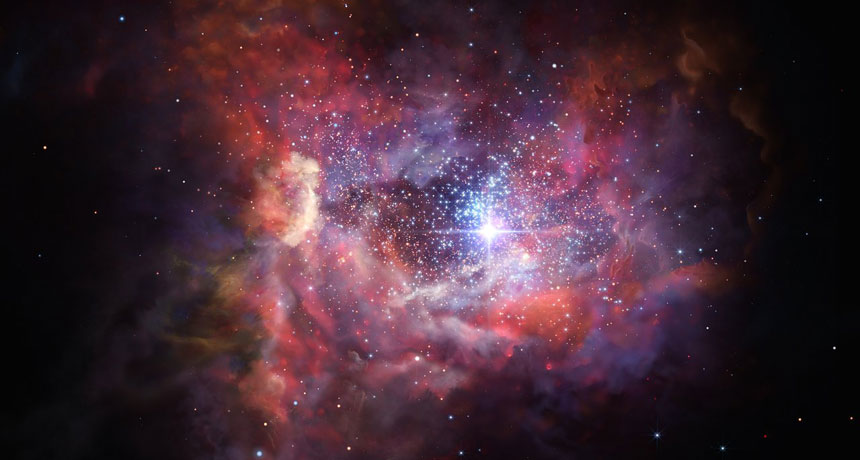Astronomers detect oldest known stardust in distant galaxy

Astronomers may have spotted some of the earliest stardust ever created in the cosmos.
Astrophysicist Nicolas Laporte of University College London and colleagues detected the dust in a galaxy seen as it was when the universe was only 600 million years old. “We are probably seeing the first stardust of the universe,” Laporte says. The observations, published online March 8 in the Astrophysical Journal Letters, could help astronomers learn more about an early period known as cosmic reionization, when ultraviolet radiation stripped electrons from hydrogen atoms.
“Dust is ubiquitous in nearby and more distant galaxies, but has, until recently, been very difficult to detect in the very early universe,” says University of Edinburgh astrophysicist Michal Michalowski, who was not involved in the study. “This paper presents the most distant galaxy for which dust has been detected.”
The galaxy, called A2744_YD4, lies behind a galaxy cluster called Abell 2744. That cluster acts as a gravitational lens, magnifying and brightening the distant galaxy’s light by about a factor of two. Laporte and colleagues observed the galaxy with ALMA, the Atacama Large Millimeter/submillimeter Array in Chile, which revealed the dust.
Dust in such a remote galaxy comes from supernova explosions of massive stars that were among the earliest stars in the universe. Astronomers estimate the first stars formed around 400 million years after the Big Bang, which occurred 13.8 billion years ago. Laporte and colleagues estimate that A2744_YD4’s dust, at 600 million years after the Big Bang, weighs in at about 6 million times the mass of the sun. “This means that supernova explosions are able to produce large amounts of dust very quickly,” Michalowski says.
Laporte and colleagues also detected positively charged, or ionized, oxygen atoms and a signature of hydrogen, which suggest the galaxy’s gas is ionized.
Cosmic reionization completely rebooted the universe so that ionized rather than neutral atoms pervaded space. Understanding this switch from neutral to ionized atoms gives clues to how stars and galaxies arose in the early universe. Finding ionized oxygen in such a remote galaxy “provides evidence that at least a fraction of cosmic reionization was caused by galaxies like A2744_YD4,” Michalowski says.
Until now, astronomers have been charting the early history of galaxies by counting them and looking at their colors, notes study coauthor Richard Ellis, a cosmologist currently on leave from University College London at the European Southern Observatory. Spotting dust in the distant universe offers a new route to determine when the earliest galaxies first formed, based on the abundances of oxygen, silicon and other heavier elements that they contain. Fewer heavy elements would point to younger and younger galaxies.
The detection of ionized oxygen could also hint that a black hole lurks at the center of A2744_YD4. Ionized oxygen, seen by the signal it emits in millimeter wavelengths, may be difficult to generate from young hot stars alone. Another strong source of ionizing radiation, such as a black hole, may be needed to account for the signature. “Unfortunately with only one emission line we cannot, for sure, claim there’s a black hole in A2744_YD4,” Ellis says.